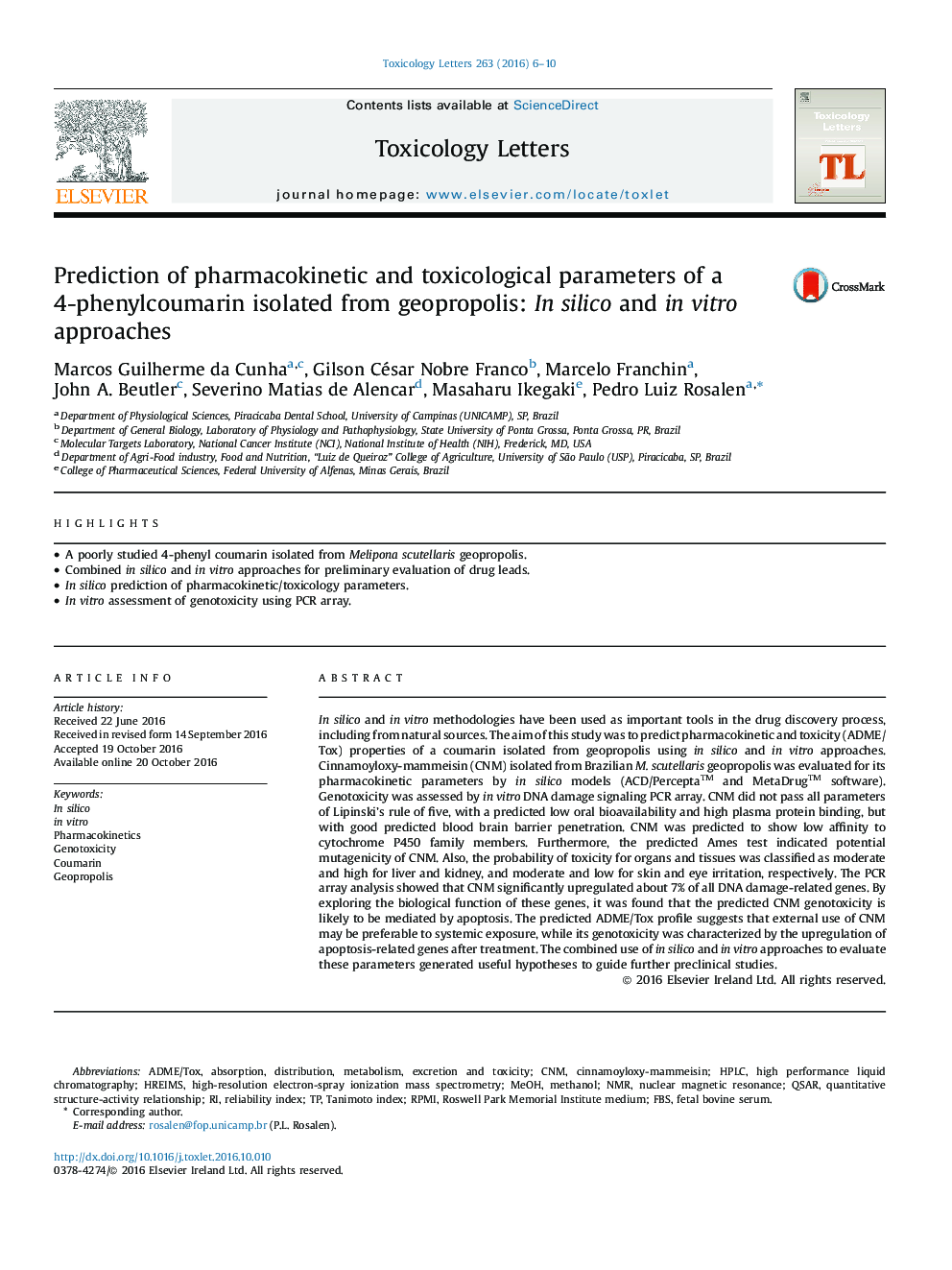| کد مقاله | کد نشریه | سال انتشار | مقاله انگلیسی | نسخه تمام متن |
|---|---|---|---|---|
| 5562211 | 1562610 | 2016 | 5 صفحه PDF | دانلود رایگان |
عنوان انگلیسی مقاله ISI
Prediction of pharmacokinetic and toxicological parameters of a 4-phenylcoumarin isolated from geopropolis: In silico and in vitro approaches
دانلود مقاله + سفارش ترجمه
دانلود مقاله ISI انگلیسی
رایگان برای ایرانیان
کلمات کلیدی
Tanimoto indexADME/ToxGeopropolisFBSCNMHREIMSRPMInuclear magnetic resonance - رزونانس مغناطیسی هستهایQSAR - بزرگسال NMR - تشدید مغناطیسی هستهای absorption, distribution, metabolism, excretion and toxicity - جذب، توزیع، متابولیسم، دفع و سمیتIn silico - درون رایانهای، این سیلیکوIn vitro - درونکشتگاهیQuantitative structure-activity relationship - رابطه ساختاری و فعالیت کمیfetal bovine serum - سرم جنین گاوGenotoxicity - سمیت ژنتیکیReliability index - شاخص قابلیت اطمینانPharmacokinetics - فارماکوکینتیکMethanol - متانولRoswell Park Memorial Institute medium - موسسه خاطرات Roswell Park mediumMeOH - مونhigh performance liquid chromatography - کروماتوگرافی مایع با کارایی بالاHPLC - کروماتوگرافی مایعی کاراCoumarin - کومارین
موضوعات مرتبط
علوم زیستی و بیوفناوری
علوم محیط زیست
بهداشت، سم شناسی و جهش زایی
پیش نمایش صفحه اول مقاله

چکیده انگلیسی
In silico and in vitro methodologies have been used as important tools in the drug discovery process, including from natural sources. The aim of this study was to predict pharmacokinetic and toxicity (ADME/Tox) properties of a coumarin isolated from geopropolis using in silico and in vitro approaches. Cinnamoyloxy-mammeisin (CNM) isolated from Brazilian M. scutellaris geopropolis was evaluated for its pharmacokinetic parameters by in silico models (ACD/Percepta⢠and MetaDrug⢠software). Genotoxicity was assessed by in vitro DNA damage signaling PCR array. CNM did not pass all parameters of Lipinski's rule of five, with a predicted low oral bioavailability and high plasma protein binding, but with good predicted blood brain barrier penetration. CNM was predicted to show low affinity to cytochrome P450 family members. Furthermore, the predicted Ames test indicated potential mutagenicity of CNM. Also, the probability of toxicity for organs and tissues was classified as moderate and high for liver and kidney, and moderate and low for skin and eye irritation, respectively. The PCR array analysis showed that CNM significantly upregulated about 7% of all DNA damage-related genes. By exploring the biological function of these genes, it was found that the predicted CNM genotoxicity is likely to be mediated by apoptosis. The predicted ADME/Tox profile suggests that external use of CNM may be preferable to systemic exposure, while its genotoxicity was characterized by the upregulation of apoptosis-related genes after treatment. The combined use of in silico and in vitro approaches to evaluate these parameters generated useful hypotheses to guide further preclinical studies.
ناشر
Database: Elsevier - ScienceDirect (ساینس دایرکت)
Journal: Toxicology Letters - Volume 263, 30 November 2016, Pages 6-10
Journal: Toxicology Letters - Volume 263, 30 November 2016, Pages 6-10
نویسندگان
Marcos Guilherme da Cunha, Gilson César Nobre Franco, Marcelo Franchin, John A. Beutler, Severino Matias de Alencar, Masaharu Ikegaki, Pedro Luiz Rosalen,